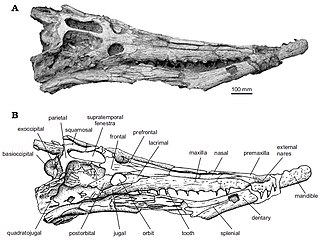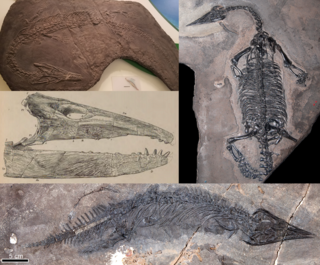
Catopsbaatar is a genus of multituberculate, an extinct order of rodent-like mammals. It lived in what is now Mongolia during the late Campanian age of the Late Cretaceous epoch, about 72 million years ago. The first fossils were collected in the early 1970s, and the animal was named as a new species of the genus Djadochtatherium in 1974, D. catopsaloides. The specific name refers to the animal's similarity to the genus Catopsalis. The species was moved to the genus Catopsalis in 1979, and received its own genus in 1994. Five skulls, one molar, and one skeleton with a skull are known; the last is the genus' most complete specimen. Catopsbaatar was a member of the family Djadochtatheriidae.

Nectosaurus is a genus of thalattosaur which lived during the Late Triassic in what is now California. The type and only known species, Nectosaurus halius, was found in the Hosselkus Limestone and described by John C. Merriam in 1905, making it one of the first thalattosaurians known.

Askeptosaurus is an extinct genus of askeptosauroid, a marine reptile from the extinct order Thalattosauria. Askeptosaurus is known from several well-preserved fossils found in Middle Triassic marine strata in what is now Italy and Switzerland.

Arambourgisuchus is an extinct genus of dyrosaurid crocodylomorph from the late Palaeocene of Morocco, found in the region of Sidi Chenane in 2000, following collaboration by French and Moroccan institutions, and described in 2005 by a team led by palaeontologist Stéphane Jouve. Arambourgisuchus was a large animal with an elongated skull 1 meter in length.

Thalattosauria is an extinct order of marine reptiles that lived in the Middle to Late Triassic. Thalattosaurs were diverse in size and shape, and are divided into two superfamilies: Askeptosauroidea and Thalattosauroidea. Askeptosauroids were endemic to the Tethys Ocean, their fossils have been found in Europe and China, and they were likely semiaquatic fish eaters with straight snouts and decent terrestrial abilities. Thalattosauroids were more specialized for aquatic life and most had unusual downturned snouts and crushing dentition. Thalattosauroids lived along the coasts of both Panthalassa and the Tethys Ocean, and were most diverse in China and western North America. The largest species of thalattosaurs grew to over 4 meters (13 feet) in length, including a long, flattened tail utilized in underwater propulsion. Although thalattosaurs bore a superficial resemblance to lizards, their exact relationships are unresolved. They are widely accepted as diapsids, but experts have variously placed them on the reptile family tree among Lepidosauromorpha, Archosauromorpha, ichthyosaurs, and/or other marine reptiles.

Thalattosaurus meaning "sea lizard," from the Attic Greek thalatta (θάλαττα), "sea," and sauros (σαῦρος), "lizard," is an extinct genus of marine reptile in the family Thalattosauroidea. They were aquatic diapsids that are known exclusively from the Triassic period. It was a 2–3 metres (6.6–9.8 ft) long shellfish-eating reptile with paddle-like limbs and a down-turned rostrum occurring in the Lower and Middle Triassic Sulphur Mountain Formation of British Columbia as well as the Upper Triassic Hosselkus Limestone of California. It has gained notoriety as a result of studies on general diapsid phylogeny.

Daemonosaurus is an extinct genus of possible theropod dinosaur from the Late Triassic of New Mexico. The only known fossil is a skull and neck fragments from deposits of the latest Triassic Chinle Formation at Ghost Ranch. Daemonosaurus was an unusual dinosaur with a short skull and large, fang-like teeth. It lived alongside early neotheropods such as Coelophysis, which would have been among the most common dinosaurs by the end of the Triassic. However, Daemonosaurus retains several plesiomorphic ("primitive") traits of the snout, and it likely lies outside the clade Neotheropoda. It may be considered a late-surviving basal theropod or non-theropod basal saurischian, possibly allied to other early predatory dinosaurs such as herrerasaurids or Tawa.

Campinasuchus is an extinct genus of baurusuchid mesoeucrocodylian from Minas Gerais State of Brazil.
Globidentosuchus is an extinct genus of basal caimanine crocodylian known from the late Middle to Late Miocene of the Middle and the Upper Members of the Urumaco Formation at Urumaco, Venezuela. Its skull was very short and robust, with large units of spherical teeth used to break the shells of molluscs as part of its durophagus diet. It is thought to be one of the most basal Caimanines, even sharing some traits with alligatorids.

Chalawan is an extinct genus of pholidosaurid mesoeucrocodylian known from the Late Jurassic or Early Cretaceous Phu Kradung Formation of Nong Bua Lamphu Province, northeastern Thailand. It contains a single species, Chalawan thailandicus, with Chalawan shartegensis as a possible second species.

Caiman wannlangstoni is an extinct species of caiman that lived in what is now the Amazon Basin and surrounding areas during the Middle and Late Miocene. Fossils of C. wannlangstoni have been found in the Pebas Formation near Iquitos in Peru and include partial skulls and isolated skull bones. Other fossils were uncovered from the Urumaco Formation in Venezuela and the Laventan Honda Group of Colombia. The species was first described in 2015. Features that in combination distinguish C. wannlangstoni from other caimans include a deep snout, a wavy upper jaw margin, a large and upward-directed narial opening, and blunt teeth at the back of the jaws. Based on the sizes of the skulls, its estimated body length is about 211 to 227 centimetres.

Gnatusuchus is an extinct genus of caiman represented by the type species Gnatusuchus pebasensis from the Middle Miocene Pebas Formation of Peru. Gnatusuchus lived about 13 million years ago (Ma) in a large wetland system called the Pebas mega-wetlands that covered over one million square kilometers of what is now the Amazon Basin.

Caelestiventus is a pterosaur genus from the Late Triassic found in western North America. The type species, Caelestiventus hanseni, honors Robin Hansen, the Bureau of Land Management geologist (BLM), who facilitated access to the excavation site.

Gordodon is an extinct genus of non-mammalian synapsid that lived during the Early Permian of what is now Otero County, New Mexico. It was a member of the herbivorous sail-backed family Edaphosauridae and contains only a single species, the type species G. kraineri. Gordodon is unusual among early synapsids for its teeth, which were arranged similarly to those of modern mammals and unlike the simple, uniform lizard-like teeth of other early herbivorous synapsids. Gordodon had large incisor-like teeth at the front, followed by a prominent gap between them and a short row of peg-like teeth at the back. Gordodon was also relatively long-necked for an early synapsid, with elongated and gracile vertebrae in its neck and back. Like other edaphosaurids, Gordodon had a tall sail on its back made from the bony neural spines of its vertebrae. The spines also had bony knobs on them, a common trait of edaphosaurids, but the knobs of Gordodon are also unique for being more slender, thorn-like and randomly arranged along the spines. It is estimated to have been rather small at 1 m in length excluding the tail and 34 kg (75 lb) in weight.

Kenomagnathus is a genus of synapsid belonging to the Sphenacodontia, which lived during the Pennsylvanian subperiod of the Carboniferous in what is now Garnett, Kansas, United States. It contains one species, Kenomagnathus scottae, based on a specimen consisting of the maxilla and lacrimal bones of the skull, which was catalogued as ROM 43608 and originally classified as belonging to "Haptodus" garnettensis. Frederik Spindler named it as a new genus in 2020.
Caiman brevirostris is an extinct species of caiman that lived during the Late Miocene, around 11.6 million years ago, to the end of the Miocene 5.3 million years ago in Acre and Amazonas, Brazil as well as Urumaco, Venezuela. Several specimens have been referred to the species, but only 3 of them are confidently placed in the species. C. brevirostris was originally named in 1987 on the basis of a single, incomplete rostrum with an associated mandibular ramus that had been found in Acre, Brazil. C. brevirostris is very distinct among Caiman species and caimaninae overall in that it preserves a characteristically short and robust skull that bears blunt posterior teeth that were built to break down harder foods. This was an adaption for durophagy, likely to crush shells of mollusks and clams which were common in the wetlands that C. brevirostris resided in.

Kyhytysuka is an extinct genus of ophthalmosaurian ichthyosaur from Early Cretaceous Colombia. The animal was previously assigned to the genus Platypterygius, but given its own genus in 2021. Kyhytysuka was a mid-sized ophthalmosaurian with heterodont dentition and several adaptations suggesting that it was a macropredatory vertebrate hunter living in shallow waters. It contains a single species, Kyhytysuka sachicarum.
Tetragonostylops is an extinct genus of mammal, related to Astrapotheria. It lived during the Late Paleocene, and its fossils were discovered in South America.
Eardasaurus is a genus of thalassophonean pliosaurid from the middle Jurassic Oxford Clay Formation. The animal would have measured over 4.7 m (15 ft) long and possessed a high amount of teeth relative to other pliosaurs. Its teeth show distinct ridges formed by the tooth enamel, some of which are very pronounced and similar to carinae, giving the teeth a cutting edge.
Archaeopithecus is an extinct genus of notoungulate, belonging to the suborder Typotheria. It lived during the Middle Eocene, in what is today Argentina.
















